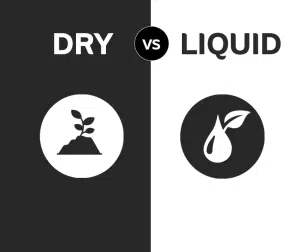
Inventory Count: Thursday, April 24th – Friday, April 25th. Resuming normal operations on Monday, April 28th. To avoid delays, check the order cutoff date: More Details
Recent Posts




Upcoming Events
Latest Comments


Before the time of the dinosaurs, our planet was covered in a vast ecosystem of forests and swamps. As time moved on, shelves of sediment moved back and forth across the land, trapping and compressing organic matter and later transforming them into coal, oil and peat deposits. However, certain ancient pockets have been found that still contain rich and valuable organic compounds. These million-year-old compost heaps called humates contain a massive supply of microbes, minerals and trace elements. Probably one of the most overlooked nutrient supplements, humate substances have the potential to enrich plants with a variety of benefits. Thinking about adding a source of humates to your feeding program? Read the following passages to learn more about the importance of humic and fulvic acid.
Humates are a mix of humic and fulvic acids and contain microbes, trace elements, minerals and metals such as nitrogen, phosphorus, potassium, calcium, magnesium and zinc. Humic acids, the larger of the two molecules in humates can be extracted from peat or lignite deposits. Fulvic acids, while made up of smaller, highly charged molecules, contain a much higher quantity of trace minerals and can become soluble in water at any pH level. Both humic and fulvic acids are the product of the slow breakdown of organic matter. Due to the microbial process required to form humates, humic and fulvic acids have developed the capacity to increase crop productivity in amazing ways.

If combined with your regular feeding schedule, humic and fulvic acid can increase nutrient uptake, water retention and general root health. Especially in hydroponic mediums like hydrostone, perlite and rockwool, humate substances are necessary for creating a root zone that can easily absorb nutrients, chelate metals and carry elements to nutrient-deprived sections of the plant.
Humic and fulvic acids have the ability to create this healthy reaction by acting both as a nutrient catalyst and chelator. It’s often that when adding humates to their regular feeding routine, growers notice increased water retention and stalk, branch and node thickening. This reaction is common after a week or so when using humic or fulvic supplements, as these acids contain a distinct catalyst function when combined with other absorbable elements. Silica, for example, is one such element that when fed along with fulvic acid becomes more readily available to the cell walls of plants.

Depending on the pH of your nutrient solution, water may have some difficulty transporting metallic salts required for plant health. Humic and fulvic acids remedy this issue by acting as a natural chelator. Silica, for example, is one such element that when fed along with fulvic acid becomes more readily available to the cell walls of plants The degree to which this process is successful, however, does depend on the pH of the nutrient solution. Calcium, for example, would have trouble being readily absorbed by plants at a pH below 5.5, even with humic or fulvic acid acting as a chelator. If buffered to a correct pH range, gardeners will see an array of results following the use of humate supplements, including thicker branches, more efficient nutrient uptake, broader leaves, tighter node spacing and larger root-balls.

GPH Uptake is a soluble formula of humic acid that aids the plant with nutrient uptake throughout its entire lifecycle. Due to the chelating results of GPH, essential immobile micronutrients such as calcium become easier to absorb by the plant. Humic acid also promotes mycorrhizal fungi colonization in the plant’s rhizosphere. Mycorrhiza allows the plant to take full advantage of the nutrients found in the root zone that would otherwise be inaccessible. This boosts the plant’s ability to produce vigorous green growth in the vegetative stage and impressive yields during the flowering stage. Use GPH Uptake in soil/soilless mediums such as peat moss, potting soil or coco for the best solubility.
GPF Uptake is a water-soluble fulvic acid supplement designed for use in hydroponic systems. Fulvic acid’s natural ability to chelate nutrients means larger molecules become mobile and available to the plant. Once absorbed, fulvic acid continues to help transport the nutrients to the parts of the plant where they are needed the most. The added fulvic acid ensures plants retain and fully utilize the nutrients they are fed. GPF Uptake can also benefit as a foliar spray application. Fulvic acid applied as a foliar spray increases the number of budding sites on a flowering plant, promotes a sturdier stalk, and overall plant structure. The fulvic humates in GPF Uptake become soluble in water easily, meaning that this product can be used in a variety of water-based systems with recirculating reservoirs.
Want to get the most out of your garden? Try adding humic or fulvic acids to your feeding schedule. For more information on the products or information mentioned in this article, contact your GreenPlanet representative directly, or your local garden supply store.
GP NUTRIENTS
COMPANY
CONSUMER
OUR WORLD
CONNECT
NEWSLETTER
usinfo@mygreenplanet.com
+1-866-913-4769
Monday: 8am – 4:30pm
Tuesday: 8am – 4:30pm
Wednesday: 8am – 4:30pm
Thursday: 8am – 4:30pm
Friday: 8am – 4:30pm
Saturday: Closed
Sunday: Closed
Week of Dec 18-22- Regular operating hours
Dec 25- Closed (Stat Holiday)
Dec 26- Closed (Non-Stat day off with pay)
Dec 27-29- Regular operating hours
Jan 1- Closed (Stat Holiday)
Jan 2-5- Regular operating hours
2 thoughts on “The Importance of Using Humic and Fulvic Acids”
I am of the opinion that humic/fulvic acid can play a critical in soil health.
We couldn’t agree more. Thanks Willie!